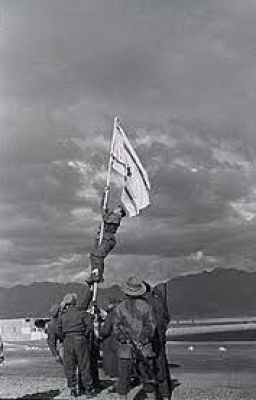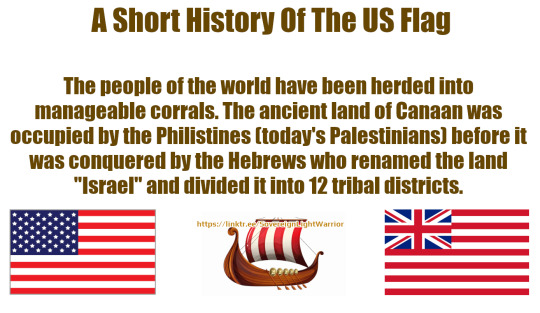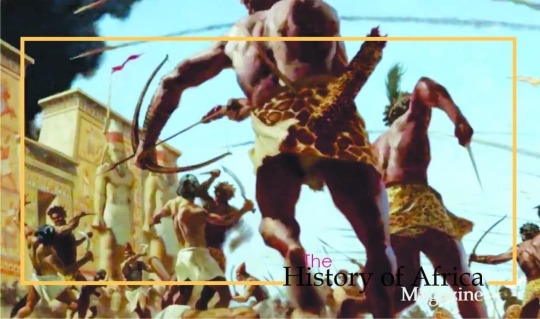#habiru
Explore tagged Tumblr posts
Text
“I always find the historic Jewish claim to the land of Israel on the basis of previous ownership to be incredibly bizarre, given that in the very document upon which they base that claim, it is established a) the Habiru stole the land from the Canaanites and b) most of it didn’t belong to them anyhow, but to one of the other tribes. How would property that Simeon stole from Joe Canaan, which was then stolen by Assyrians and later stolen by Romans, then Arabs, and finally the British, before being stolen by European Jews somehow properly belong to a genetic heir of Judah?”
VOX DAY
2 notes
·
View notes
Text

THE GOLDEN AGE OF THE MOORS.
During the European Dark Ages, between the 7th and 14th century AD, the Moorish Empire in Spain became one of the world's finest civilizations. General Tarik and his Black Moorish army from North-west Africa conquered Spain after a week long battle with King Roderick. Starting in April of 711 AD, the conquest of the whole of the Iberian peninsula took 7 years afterward. The word tariff and the Rock of Gibraltar were named after Jabal Tarikh. They found that Europe, with the assistance of the Catholic Church, had returned almost to complete barbarism and blood letting. The population was 90% illiterate and had lost all of the civilizing principles that were passed on by the ancient Greeks and Romans.
The Moors reintroduced mathematics, medicine, agriculture, and the physical sciences. The clumsy Roman numerals were replaced by hindu-arabic figures including the zero and the decimal point. As Dr. Van Sertima says, "You can't do higher mathematics with Roman numerals." The Moors introduced agriculture to Europe including cotton, rice, sugar cane, dates, ginger, lemons, and strawberries. They also taught Europe how to store grain for up to 100 years and built underground grain silos. They established a world famous silk industry in Spain. The Moorish achievement in hydraulic engineering was outstanding. They constructed an aqueduct, that conveyed water from the mountains to the city through lead pipes, from the mountains to the city. They taught Europe how to mine for minerals on a large scale, including copper, gold, silver, tin, lead, and aluminum. Spain soon became the world center for high quality sword blades and shields. Only Byzantine rivaled Moorish Spain in beauty. Spain was eventually manufacturing up to 12,000 blades and shields per year. Spanish craft and woolen became world famous. The Moorish craftsman also produced world class glass, pottery, vases, mosaics, and jewelry.
The Moors introduced to Europe, paved, lighted streets with raised sidewalks for pedestrians. Education was made compulsory, before then, during Greek and Kemet era, education was only for a specified few. The university of Salamanca was built and taught in by African scholars, Arabs and a few habiru(Hebrew speaking groups). Soap was reintroduced into Europe by the Moors; Europe had stopped bathing long after the fall of Rome in the 5th century CE. This had resulted in several plagues that almost decimated the population of Europe, among other factors like constant bloodletting in the name of religion.
Kindly subscribe to Our African History Channel
https://youtu.be/6dQLsJlUkwI
https://youtu.be/6dQLsJlUkwI
#Galdeediaries #mightyafricanhistory
9 notes
·
View notes
Text
Exodus 2: The Birth Of Moses / Moses Escapes To Midian
Overview:
Moses was born during the time when Pharaoh ordered to kill all firstborn boys. His mother put him in the basket and floated him to the river where the princess of Egypt saw him. She let the maid get Moses and asked a Hebrew nurse to take care of him. The Hebrew nurse which was Moses' mother took care of him until he was old enough and gave him back to the princess who took him as her own son. When Moses was older, he went to visit his own people and he saw an Egyptian beating a Hebrew. Looking in all directions to make sure no one was watching, he killed the Egyptian. He went out again and saw two Hebrews beating each other and he questioned one why he was beating his own brother. The guy asked him if he would kill him as well like the Egyptian. Pharaoh heard this news and was angry to Moses and ordered to kill him. So Moses ran away to Midian.
Points To Remember:
When Moses was in Midian, he saw daughters of the priest trying to draw water from the well when shepherds came and chased them away. Moses rescued the girls and went to tell their father.
The Father invited Moses to their home and later on gave one of his daughters as his wife, Zipporah.
Years passed, Pharaoh died. The Israelites was still under brutal slavery, and God remember His promise to Abraham, Isaac, and Jacob. He looked down to His people of Israel and knew it was time to act.
Lessons Learned:
God always remembers His promises and acts it when it is the right time.
Moses loved his people so much and even wondered why they are able to even hate each other. He does not like the sight of seeing his own people fight against each other. Likewise, we are also called to love God's own people just like how God loves them.
Israelites are called "Hebrews". This started because foreigners used to call the immigrants as Hebrews (from the word Habiru = a propertyless immigrant social class mentioned in many ancients texts.)
0 notes
Text






Y'all they think they are the hyksos aka as the habiru and i'm the crazy one
0 notes
Photo

The Inevitable Two State solution - The Inevitable Two State Solution
A BRIEF HISTORY OF ISRAEL Israel's history and Jewish history are both intertwined inextricably. The primary source of their history can be obtained from ancient Hebrew texts like the Pentateuch, the Talmud, the biblical books of Kings and chronicles, the book of the Maccabees, and also the writings of Flavius Josephus. The writings of Flavius Josephus are somewhat akin to the historical accounts of Thucydides for the ancient Greeks, Livy and Gaius Suetonius Tranquillus account of imperial Rome, and Herodotus' account of ancient Egypt. Archaeological findings corroborate the biblical accounts of the Canaanites as the original inhabitants of the ancient land of Israel before the habiru, a nomadic people mentioned in Assyro-Babylonian literature from 2000BC, and often identified as the Hebrews of the Bible. The most recent of such archaeological finds was the discovery of a 3000 year old Canaanite temple, unearthed in Southern Israel by Yosef Garfinkel of the Hebrew University of Jerusalem in the year 2020.One of the discoveries was an idol of the Canaanite god Baal, which is mentioned frequently in many old testament texts of the Holy bible. According to Jewish tradition, the temple of Solomon, also known as "The first Temple," was built by the biblical King Solomon[990-931]. The first Temple went through different phases of destruction and desecration under the oppressive rule of the Babylonians before it was restored and reconstructed by the Medes and Persians between 520-515BC. The restoration led to the emergence of the "Second Temple." The second Temple was desecrated again by Antiochus IV[Epiphanes], the king of Syria of the Seleucid dynasty, and one of the successors of Alexander the Great. He desecrated the temple by offering the sacrifice of a pig on an altar to Zeus. This abominable act of his, deemed sacrilegious by the Jews, led to a rebellion by the Maccabees, under the leadership of Judas Maccabeus from 167-160 BCE. The successful rebellion is marked yearly in the festival of Hanukkah in honour of the recapturing of Jerusalem, cleansing of the second temple, and rededication of the altar. The Second temple was utterly destroyed by the Romans, under general Titus in the year 70AD, as a retributive measure against Jewish insurrection. The Sicarri were a splinter group of Jewish zealots who, in the decades preceding Jerusalem's destruction in AD 70, strongly opposed the Roman occupation of Judea, and the final destruction of the second temple. They found refuge in the fortress of Masada, from where they rebelled against the Romans. In 73AD, their rebellion ceased, when they all committed mass suicide at Masada.The Roman emperor Hadrian cursed the Jewish people and decreed that Judea should be henceforth called "Palestine" after the age-old traditional enemies of Israel, who had more or less vanished from the world stage about 600 years earlier. In 132AD, Simon Ben Koseba, a Jewish military leader led another rebellion against the imperialist Roman government to re-establish the Jewish state that had fallen in 70AD. The Bar Kokhbar revolt, as it was then called, turned out to be a fiasco, and Ben Koseba was killed by the Roman forces. At the very outset of the rebellion, he had been seen by many of his Jewish country men to be the long expected messiah. Jewish communities proliferated in Europe, the middle east, the far east and North Africa. The Hebrew word "Aliyah," which literally means "immigration to Israel, or ascent to Jerusalem," became synonymous with Jews in the diaspora. Their dream of moving back to Jerusalem, or the land of Israel or Judea, as it was then called, became a long expected dream for centuries. Pervasively, the Jews were persecuted by their host communities, especially in Europe. Examples abound with the Alhambra decree of 1492 by Queen Isabella I of Castille and her husband, Ferdinand of Aragon. This draconian decree expelled all the Jews resident in both medieval Kingdoms of present day Spain. Another was the coercive conversion of Jews to Catholicism, which was enforced by King Manuel I of Portugal in the year 1496. In some cases, large sums of money were extracted from Jews by their overlords in some European kingdoms. A very good example was that of the English king Henry III, who imposed heavy taxes and forced gifts on the Jewish population. His son, and successor king Edward I became the first English king to be out-rightly antisemitic, when he expelled Jews in 1290.The other historical accounts of persecutions against Jews were the pogroms of the Spanish inquisition in the middle ages, and the pogroms that happened in the Russian empire between the late nineteenth and early twentieth centuries. The exit of Jews from eastern Europe in the late nineteenth and early twentieth centuries, recorded tremendous successes through the birth of companies like, Twentieth Century Fox, Metro-Goldwyn Mayer, Warner Bros and Paramount Pictures in the United States.In the late nineteenth century, the Zionist movement was gathering momentum. Popular people attached to this movement began to champion and spearhead the cause of establishing a national home for the Jews in Palestine. Theodore Herzl was the founder of this movement. Before him, there had been a proposal to establish a national home for the Jews in the early nineteenth century by the French emperor, Napoleon Bonaparte. His proposal failed. Another proposal came from the British colonial secretary, Joseph Chamberlain in the form of the "Uganda Scheme" in 1903.It was presented as a temporary refuge for Jews who wanted to escape widespread antisemitism in Europe. The proposal faced opposition from the Zionist movement. The British mandate in Palestine, which had been created after World War 1, with the Sykes-Picot survey/plan, gave its support for the establishment of a "National home for the Jewish people." Antisemitism saw its climax in Europe during the holocaust. Between 1933-1945, the Nazis had embarked on ethnic cleansing programmes like; The night of the broken glass, The Madagascar plan, and the final solution. The final solution, orchestrated by Reinhard Heydrich, led to the holocaust, which decimated over six million Jewish lives.The May 15th, 1948 rebirth of the state of Israel, led by its first prime minister, David Ben Gurion, led to the foundational events of the "Nakba" in which dozens of massacres targeting Arabs were conducted, and about 400 Arab-majority towns and villages were depopulated; with many of these being either completely destroyed or repopulated by Jewish residents and given new Hebrew names. This declaration of independence ignited the first Arab-Israeli war of 1948. Prior to this independence and devastating conflict, terrorists' Organizations like Irgun and Haganah had been created in Israel to spearhead the independence movement by employing acts of terror. Some of their nefarious activities were; the bombing of the king David Hotel in 1947, the hanging of two British soldiers that had been abducted by them, other acts of terror against the British for restricting Jewish immigration at some point, and the brutal assassination of United Nations chief negotiator, Folk Bernadotte. The second Arab-Israeli War/crisis came as the aftermath of the nationalization of the Suez Canal by Gamal Abdel Nasser of Egypt. A French, British, and Israeli coalition attacked Egypt, but soon withdrew under international pressure. The third Arab-Israeli War was fought between Israel and a coalition of Arab states, primarily Egypt, Syria and Jordan. At the end of the conflict, Israel had seized Syria's Golan heights, the Jordanian annexed West Bank and East Jerusalem, Egypt's Sinai Peninsular and the Egyptian occupied Gaza Strip. The Yom Kippur War was the fourth of the Arab-Israeli conflict. It happened during the Jewish holiday of Yom Kippur, and the Islamic holiday of Ramadan. Egypt and Syria both attacked Israel simultaneously, with the intention of recapturing lost territories in the 1967 six day War. There were other minor and relatively prolonged conflicts like the War of Attrition in 1970, the invasion of Lebanon in 1982, Israel-Hezbollah war of 2006, and other minor skirmishes with either Hamas or Hezbollah. The first Arab country to sign a peace treaty with Israel was Egypt in1979. The peace treaty was brokered by US president Jimmy Carter in Washington D.C. The other signatories were Anwar Sadat of Egypt and Menachem Begin of Israel. This treaty with Egypt led to the ceding of the Sinai peninsular to Egypt, after eleven years of Israeli occupation. Israel withdrew from the Gaza strip in 2005, after nearly 38 years of occupation. The most recent conflict is the Israel-Gaza War, caused by the "operation Al Aqsa Flood of October 7th, 2023." It came a day after Israel marked the 50th anniversary of the Yom Kippur War. Zionism has to a very large extent benefitted the Jews through the re-establishment of the state of Israel on May the 15th, 1948.Theodor Herzl, Chaim Weizmann and David Ben Gurion did achieve the elusive "Aliyah dream," but at a heavy cost to the Arab population. It is estimated that between 500,000 to 750,000 Palestinians were displaced by Israel's independence, and about 15,000 were massacred in 1948. In the ongoing conflict today, at least 25,000 Palestinians have been killed as reprisals for about 1,200 Israelis, mostly civilians, massacred by Hamas. Hundreds were taken hostage, a few of whom have been released in a prisoner swap with Israel during a truce. A Brief History of Gaza: The history of Gaza spans over 4,000 years. In ancient times, it was originally a Canaanite settlement, just like the ancient land of Israel. It had been under the control of different kingdoms, Empires, dynasties, and nations, notably; Egypt, Assyria, The Philistines, Babylon, and Greece, under Alexander the Great. In the early 16th century, it came under the control of the Ottoman empire. After World War 1, Gaza became administered by Great Britain, under the British Mandate of Palestine, largely due to the Sykes-Picot survey of the middle east. The Ottoman empire lost their control of it, as a result of the treaties of Sevres and Lausanne. Following the 1948 Arab-Israeli War, Egypt administered the newly formed Gaza strip, whilst Jordan took charge of the West bank. The West Bank and Gaza were both captured by Israel in the six day war of 1967. Israel has maintained its control of the West Bank, ever since it was captured, and has officially absorbed East Jerusalem as its capital. Another area of land that was under Jordanian control until 1967. Israel officially withdrew from the Gaza strip in 2005, after 38 years of occupation. The Palestinian Liberation Organization[PLO] was founded in 1964. Yasser Arafat and his Fatah faction controlled the PLO until 2006 when Hamas, an organization considered a terrorist organization by the West, took charge of the reins of power. Hamas was founded in 1987 by Ahmad Yassin. It was founded after the first intifada. It had carried out acts of terror against Israel, the worst of them was the "Operation Al Aqsa Flood" on October the 7th, 2023, when about 1,200 Israelis were massacred, and hundreds were taken hostage. Conclusively, I would say that the flow of blood for nearly seventy-four long years has been to say the least, terribly costly for both Jews and Arabs. The best and the only solution to this protracted conflict that has bedeviled the region for many decades is "a two-state solution."
0 notes
Photo

Habiru and Nicolle A - We will recommend this dealer to our friends.
0 notes
Text
➝ A Short History Of The US Flag 🧩 The people of the world have been herded into manageable corrals. The ancient land of Canaan was occupied by the Philistines (today’s Palestinians) before it was conquered by the Hebrews who renamed the land “Israel” and divided it into 12 tribal districts. By 69AD, the Roman soldiers destroyed the Hebrew Temple of Solomon, burned Jerusalem to the ground, gave the land back to the Philistines and renamed Israel “Palestine”. The 12 Hebrew tribes fled and dispersed from the land. vikingsWhere did the Hebrews go? The Hebrew tribe of Dan adopted the symbols of a dragon and a snake and emblazoned them on their red and white flag together with the crest of an eagle. The carvings of snakes and dragons on their ships, the red and white stripes on their sails and archeological relics reveal that the tribe of Dan became the dreaded Vikings. The Tribe of Dan settled in Greece along the River DANube and became a ferocious force of brutal seafaring pirates. They named themselves after their ancestral Hyksos Kings (Habirus-Hebrews) who had ruled Egypt as the 15th Dynasty. VI Kings = 6 Kings = VIKINGS They pirated their way along the Mediterranean and sailed up the coast of Europe marking their migration trail by naming mountains, towns and rivers after themselves. The river Danube and the Jordan River. Denmark literally means, “the mark of Dan”. Since the original Hebrew language had interchangeable vowels, the name of Dan can also be spelled Din, Den, Dun or Don. ScanDINavia, LonDON, SweDEN and DENmark are all marked by Dan. https://thegreatwork208716197.wordpress.com/2023/03/04/a-short-history-of-the-us-flag/

0 notes
Text
I'm not annoyed because i know what they mean
i think if you take this consistently, you can't even call judaism as it is practiced now "antique'.
firstly jews alive now are practicing a religion that's practiced now. you ask them why - especially in America or Israel, and they will point to early modern traditions in the country their ancestors came from and mention all the rabbis who invented Orthodox and Liberal Judaism in that period, so is Judaism actually not contemporary, but early modern?
No, because the early modern jews were building off mediaeval jews, who founded basic categories like the Ashkenazim and the Sephardim, and set up the recognisable forms of Jewish life -- you see this in arguments like "antisemitism (always constitutive of Judaism) dates back to when Edward II expelled the jews and invented the Blood Libel". So is it a medieval religion?
Obviously not because those nations have their roots in late antiquity, the diaspora, the formation of the rabbi class etc.
And Judaism isn't a late antique religion because it's obviously rooted in earlier antiquity, where "judaism" was invented, and the torah was written, so can we settle by saying it's Iron Age?
No because they didn't make it all up then out of nothing. Just like in every previous step, - the material comes from earlier times, but eventually we reach a point where we enter into prehistory, and this provides the place where we're forced to stop - in the Bronze Age Levant - with speculation about questions like what relation the bronze age Habiru have to the bronze age mythology in early Jewish history, cognates with texts in sister nations and enigmatic references in Egyptian and other sources.
Why are we supposed to be privileging the Iron Age as our polemic term for judaism? Are we even, or is it just a petulant and nerdy reaction 'well... actually" to the accusation of it being Bronze Age? Defending a claim to antiquity, but holding back just enough that your interlocutor is Antisemitic...
i think danielle already complained abt this but its so annoying when people describe judaism as bronze age. the bronze age ended by 1100 BCE! i mean, technicaly judaism CLAIMS to originate in the bronze age (ppl calculate moses to like, 1300 ish), just barely, but the torah certainly doesnt date to the bronze age, even the stuff it derives from isnt generally believed to be older than like 800 BCE afaik, so its more iron age. or very early antiquity
22 notes
·
View notes
Photo

Throughout the centuries of life on earth, there's always been a tei e of people above special.. Yea yes, I descend from them. Ya heard 🇭🇹🇭🇹🇭🇹🇭🇹🇭🇹🇭🇹🇭🇹🇭🇹🇭🇹 #1804#TheRevolution #NégAyisyen #Haiti 🇭🇹🇭🇹🇭🇹🇭🇹🇭🇹 #Habiru #Warriors #AntiSlavery #Hebrew #Israelite #Levi #PriestHood #Maccabees #Hammer https://www.instagram.com/p/CMptYkzDqtr/?igshid=1q2a74126t0z6
#1804#therevolution#négayisyen#haiti#habiru#warriors#antislavery#hebrew#israelite#levi#priesthood#maccabees#hammer
0 notes
Text
Urith Habiru

The Icicles of Urith Habiru
• [x] grow long and sharp and cold
• [x] pose a danger to all that is below
• [x] drip cold water
• [x] cling to buildings
• [x] make everything colder
• [x] are made of ice
• [x] trap light
3 notes
·
View notes
Photo

Apollo & Pitbul from the upcoming >PHERES: WHAT’S THE USE OF FEELING BLUE? thread.
12 notes
·
View notes
Text

~ via The History of Africa Magazine
WHEN AFRICA RULED THE WORLD IN PEACE
In 744 BCE, king Piankhi (King of Kush, a massive kingdom known as Aethiopia at this time, when there existed upper Aethiopia and Lower Aethiopia, the citizens of which were called Aethiopes by tribal groups like the Nabataean, habiru or Hebrews and the historian, Herodotus), ordered an attack on Mekuria and the Nile delta region. It was a 'holy war' meant to reclaim the throne of the Pharaohs, which was then occupied by groups from across the Mediterranean, that had usurped the throne.
King Piankhi had ordered his army to cleansed themselves in the river before going into battle, and to fight nobly and announce the time of their attack to the adversaries before attacking; an attack for which he insisted most be during the day and not at night. Piankhi's army won a swift victory. He spared the lives of all the nobles and the young king he dethroned.
This victory was an African Renaissance and it ushered in an era of African spirituality. Abydos was reinstalled as the holy seat of the African God, Ptah and Gebel Barbal mountain in lower Aethiopia(Kush), where we have Sudan today, which was a holy place of worship, was cleansed and reestablished.
Abydos(5000 BCE), in ancient time was the first place of pilgrimage in the whole world. Africans often travelled through the Sahel and along the Nile to gather in Abydos for spiritual observance. The Sahara was not a desert at this time until 3100 BCE. This was thousands of years before Greece, Rome, Jerusalem and Mecca came into existence. It was before there was a concept of a Jehovah(God of the habiru, the patriarchy of which came into existence in 1675 BCE), Dushara(God of the Nabataean which was represented in a square block and crescent moon in a shrine, the ruins of which can still be visited today in Petra and Hegra... which became known by the generic name as 'alat' in the 1st century BCE and as 'allah' during the 7th century CE). It was before any Legend of Yeshua of Judea or a Mohammad of Arabia came into existence. It was millennia before there came into existence the concept of Judaism(10th century BCE), Zoroastrianism (about 9th century BCE), Samaritanism(7th century BCE), Christianity(33/34 CE, centred around the veneration of a Hebrew Rabbi), Christendom(325 CE, from the council of Nicea, which was founded on a political decision by emperor Constantine of the eastern Roman empire, aimed at halting the decline of Rome), Mohammadanism(a sociological ideology that became a religious movement known as Islam in the 7th century CE).
Abydos was to some Africans what Rome, Jerusalem or Mecca is to many today. It was like what 'ile-ife,' 'the home of creation' was to the Yoruba people, or like 'Swam' was to the ancient Tiv people of West Africa. The first of such a place to have come into existence outside of Africa happened at about the 10th century BCE in Jerusalem among the Hebrews, and in the 2nd century BCE when the Nabataean began to settle in Petra, this place of gathering was later to be known as 'masjid Al haraam,' from the 4th century CE, after an earthquake in Petra.
It might be hard for many to understand the fact that, there was a time in the world when there was no Judaism, Christianity or Islam, whatsoever, the world over. But that was a time when the "African ruled the world in peace." -(Runoko Rashidi). Europe had not entered into history yet. The ice-packed land existed, but there were no groups like the Magyars, the Saxons, the Franks, the Almain, the Picts, the circassians and so on, as a people yet. It most be noted too that, it was the thousands of years rule by the African that made the Africans and Africa a target for all imperialists who came afterwards. For "Africa always had what others needed but weren't willing to pay for"-(Dr John Henrik Clarke).
4 notes
·
View notes
Text
It should be noted that everyone came from a mutated female they call mitochondrial Eve in Africa on the equator. The warmest place on earth at the time as it was the ice age. Very cold. And humans were pale because of the cold climate then. The first humans during the ice age were white. According to science.
Science said that the European turned white because of the colder climate up north but the tribes who went there did it during the ice age. It's the ones who stayed in the middle east and Africa who tanned according to science.
Also those who are trying to argue against African born should note that the Bible says that the garden was where the Nile meets the Tigris and Euphrates and the Blue Nile which is on the equator south of Egypt right where the habiru tribe or the Hebrew people came from and right where the video shows it.
3 notes
·
View notes
Note
I have a legitimate question about Judaism. So I was raised Baptist and my father was always weird about other christians. He hated lutherans, protestants, and catholics. But always made sure we respected hebrews. In fact we were never allowed to use the terms Jew, Jewish, or Judaism. It was always Hebrew and the Hebrew faith. My question is "is there a difference?" And if not then does using either term matter?
OK, so I'm not an expert but my gut is that "Hebrew" used in that way isn't necessarily offensive, just weird and a bit outdated, and that nowadays Hebrew is used almost exclusively to refer to the spoken and written language. Fortunately, I have an expert on speed dial, so I ran it by my dad, who happens to be a rabbi and scholar who specializes in Jewish-Christian relations. He says:
You are correct. There was a time when the term Jew was avoided by some Jews because of the negative connotations connected to it. Hebrew was perceived as less laden. Hence the Union of American Hebrew Congregations (now the Union for Reform Judaism) and the Hebrew Immigrant Aid Society (now HIAS, which does great work!) Historically, Hebrew is biblical - Abraham is called a Hebrew and Jonah identifies himself that way. I am emailing you a short article about the term both in the tanach and after if want to nerd out. I’m guessing your friend’s father also viewed the term Jew (also mainly a post biblical word) as pejorative while Hebrew was considered more respectful.
*Tanach or tanakh is how Jews refer to the Bible.
Anyway, I like being told I'm right! I will add that some Jews still don't like non-Jews using the word "Jew." Though I'm not one of them and I've only very recently heard that anyone still felt this way, if you want to err on the side of caution, "Jewish person" is the safest way to go. To the extent that all Jewish people can ever agree on anything, I think we’ll all agree on this.
The article he mentions is actually the full definition of “Hebrew” cut and pasted from The Anchor Yale Bible Dictionary (1992) and is extremely dry. I’ve placed it below the cut if you’re really interested.
HEBREW [Heb ʿibrı̂ (עִבְרִי)]. In English, generally synonymous with “Jew,” but in the Hebrew Bible it mostly designates members of the Israelite nation.
The use of this expression is confined to certain parts of the OT, the story of Joseph (Genesis 37–50), the history of Israel in Egypt (Exodus 1–15), and 1 Samuel. Apart from these major narrative compositions the Hebrews are mentioned in a few other passages, notably in Gen 14:13, where Abraham is called a Hebrew; in the Book of the Covenant, Exod 21:2–11, which regulates the service of Hebrews who had been enslaved; and in texts dependent on this law (Deut 15:12; Jer 34:8–20; see Lemche 1976: 43–45, 51–53). Finally, in Jonah 1:9 the prophet describes himself as a Hebrew who has run away from his country. The last mentioned example is the only one where a person describes himself as a Hebrew, in all other instances they are described as such by other peoples, in the story of Joseph and in Exodus by the Egyptians, in 1 Samuel by the Philistines.
The etymology of the expression is not yet totally clear (see proposals in Loretz 1984: 235–48) and the possible derivation from the Akkadian expression ḫabiru/ḫapiru, thought to mean a population element of fugitives and outlaws, remains a subject of discussion. See HABIRU, HAPIRU. This discussion about the connection between Hebrews and ḫabiru/ḫapiru is, however, fundamental for understanding the ethnic term “Hebrew” in the OT. If this derivation is correct, it would hardly be reasonable to deny the significance of the more general ḫabiru/ḫapiru-movement in the ANE in the 2d millennium b.c. for the population processes in Palestine and adjacent areas which led to the formation of the Israelite society in the early Iron Age, just before 1000 b.c. (against Loretz 1984; cf. already Mendenhall 1962, and 1973: 122–41). Therefore the rise of the Israelite nation cannot be separated from the social upheavals during the Late Bronze Age, of which the ḫabiru/ḫapiru-movement is evidence. According to this view we shall have to reckon with a considerable element of ḫabiru/ḫapiru in Late Bronze Age Palestinian society as one of the single major factors behind the emergence of Israel.
Since the expression ḫabiru/ḫapiru evidently covers a social phenomenon, whereas Hebrew in the OT, with perhaps one exception (Exod 21:2–11, the law concerning Hebrew slaves), always stands for members of the Israelite people, a certain shift of meaning has taken place. It is, however, interesting to note how some aspects of the former social meaning of the expression have survived almost everywhere in the OT where the expression is used (Lemche 1979; see also Naʾaman 1986). Thus in the story of Joseph and in Exodus, the word “Hebrew” is always used to refer to the Israelite refugees in Egypt, in contradistinction to the local population or authorities, and in 1 Samuel only the Philistines speak about Hebrews, normally in a derogatory sense, to indicate runaway slaves or renegades (David, who is considered to have deserted his own master, King Saul, is thus styled by his Philistine superiors in 1 Sam 29:3). Even in such late texts as Gen 14:13 and Jonah 1:9, relicts of the former sociological meaning of the expression may be supposed to be behind the present usage.
Irrespective of the relative age of those texts in the OT which mention the Hebrews, it is therefore true to maintain that the OT usage is based on an old and historical tradition. On the other hand, it is hardly possible to argue that all instances are postexilic, or that the use of the expression also derives from such a late period as maintained by O. Loretz (1984: 271–75). First and foremost, in the postexilic and pre-Hellenistic periods, “Hebrew” was never understood as a general term denoting ordinary Israelites or Jews. Moreover, in Exod 21:2–11 we have a testimony of the survival in Israel of an age-long societal connection; here two distinct terms are used which in the Late Bronze Age indicated two different though interrelated social categories (the ḫabiru/ḫapiru and the ḫupšu [Heb ḥopšı̂] respectively, i.e., “peasants” according to general opinion [a variant interpretation is mentioned by Lemche 1975: 139–42, “copyholders,” or simply “clients”]). These distinctions disappear completely from Near Eastern documents after the collapse of the Bronze Age social system.
Only in the Greco-Roman tradition did Gk Ebraios become the ordinary way of indicating Jews, and thereafter this tradition was taken over by the Christian Church and became a general way of designing members of the Jewish people. The three passages using the term Hebrew in the NT (2 Cor 11:22; Phil 3:5; Acts 6:1) do not enlarge the meaning of the expression. In 2 Corinthians and Philippians, Paul calls himself a Hebrew, thus indicating that he is a Hebrew-speaking Jew in contrast to those Jews whose language is Greek, or perhaps he wanted to distinguish between himself as a Jew and the Gentiles. In Acts the expression is applied to characterize the so-called Jewish Christian congregation.
ANE Ancient Near East (ern)
2d second
Lemche, N. P. (1992). Hebrew. In D. N. Freedman (Ed.), The Anchor Yale Bible Dictionary (Vol. 3, p. 95). New York: Doubleday.
#Jew vs Jewish person gets into sticky reclaimed slur territory like LGBT vs Queer#I'd prefer not this not to become a 'let's ask HQJH to text his dad questions' blog but I do like answering questions :)#and do know plenty myself lol#asks answered#jews#jewish#Jewish Tumblr#Judaism#jews and judaism#jumblr#hebrews#hebrew#yard-3103#post o' mine
19 notes
·
View notes
Photo

Congratulations Habiru and Nicolle on your #Acura #MDX from Gavin Samples at Hiley Acura!
0 notes
Text
Company of the Dead Dreadnought #3: Ancient Hezekia





Born as Ibrahim Gelt, Hezekia was part of the first generation of Chemos born Astartes. As the son of an Archaeotech scavenger, Hezekia developed a love for machines and was eager to serve with the Legion’s armored formations. Indeed, Hezekia’s high marksmanship rating might well have seen his career take a different path but for his persistence.
Assigned to 9th Company’s motor pool, Hezekia spent a great deal of his career driving or navigating RH1N0 pattern transports before a promotion to command of the Sicaran Venator tank destroyer “Hekate.” When he was not engaged in his duties, Hezekia had an enduring love for “obsolete” or extinct musical instruments, and restored or fabricated several, learning to play each. Upon his interrment, he had gathered a small but rather valuable collection, which was subsequently bequeathed to the Terran Archives.
At Kadda-Ran entering his second decade with Hekate, Ibrahim Gelt was a part in one of III’s largest tank battles before the Heresy, engaged with Aeldari tanks and armored vehicles that had achieved parity in numbers with the Astartes. Despite significant losses, the Emperor’s Children managed to win the multi-day battle, losing two fifths of their armored vehicles in the process. Gelt was among those lost on the third day of fighting, accounting for four Eldar tanks and one Walker prior to somewhat ironically losing Hekate and her crew to a xenos tank destroyer. Crushed by the wreckage and severely burned, Gelt was interred and his stasis coffin installed within the chassis of a Contemptor. He served with honor for many decades with the honorific “Hezekia” in memory of a an ancient Habiru king.
At Isstvan III, Hezekia’s career nearly ended. His dreadnought drop pod, part of the first wave, was downed by Istvaanian defense batteries and could not open its doors. There he might have suffered a second death if not for the actions of another dreadnought - Venerable Sarpedon - in a tale for another entry. He was evacuated with the hard bitten loyalist survivors under Crysos Morturg.
The damage to Hezekia’s chassis was considerable, and he was transferred to what was at hand: a Contemptor-Proteus chassis. With the Company of the Dead, he most commonly mounts twin linked lascannon, power fist, and hunter killer missile.
Hezekia is an odd conversion, but people seem to like him. He was built from a damaged Rogue Trader era Contemptor Dreadnought, and pieces of two different Castaferrum models from a bargain bin. The etched brass, as usual, is FW. Although easily the size of a contemptor, I usually run him as a standard box-naught, though he did so well for me in our last engagement that this may change.
5 notes
·
View notes